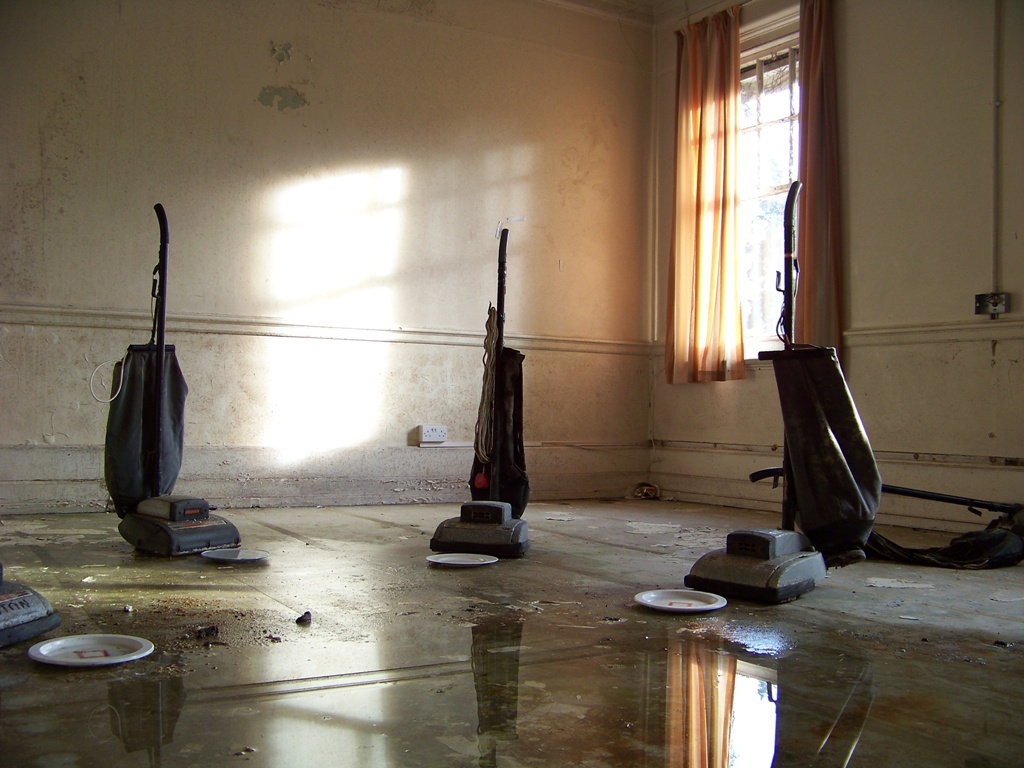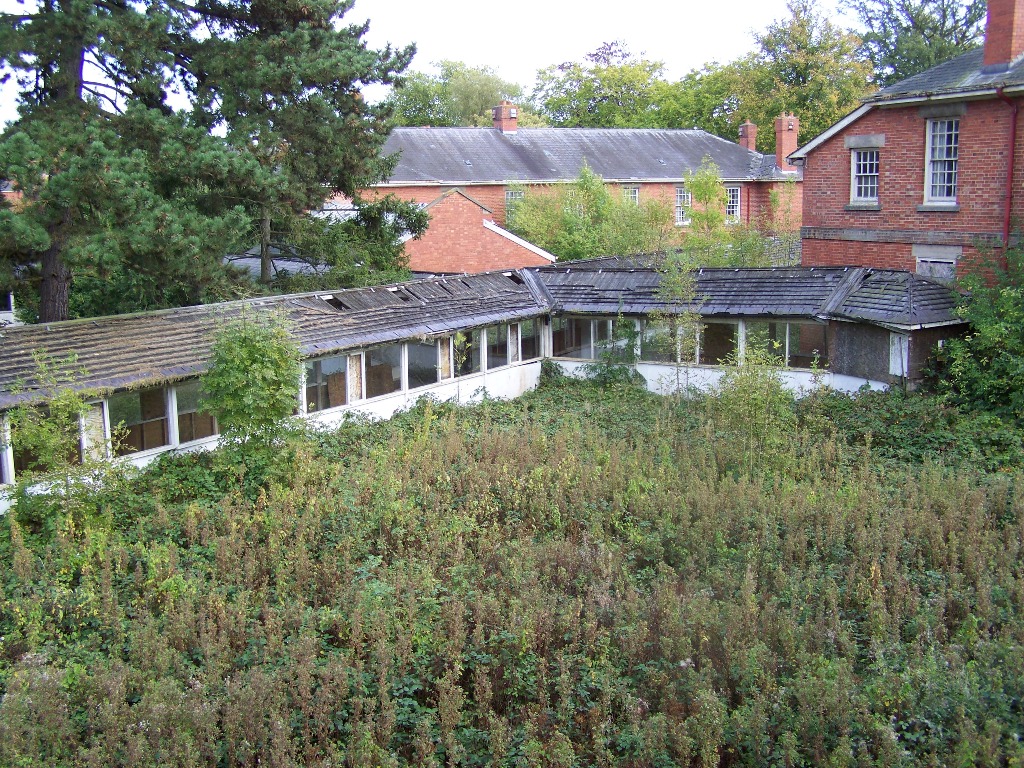West Park Hospital
Toggle site summary [+/-]
What:Mental Hospital
Where: Epsom, Surrey
Built: 1913-1924 with additions in 1950, 1970s and 1980s
Architect: William C. Clifford Smith
Abandoned: 1993-2003
Listed: Water tower only, Grade II.
Visited: 2009-2013
Last Known Condition: Mostly demolished; some buildings retained for conversion
Page Updated: October 2024
Designed by William C. Clifford-Smith RIBA, West Park was the last of a cluster of mental hospitals to be
built by the London County Council on the Horton Estate near Epsom between 1899 and 1924.
Construction of West Park began before the First World War but was interrupted by lack
of workforce and resources following conscription. The part-completed buildings were used by the
Canadian Military until the end of hostilities, after which construction resumed; the hospital
opened to patients in 1921, with the last buildings completed in 1924. The finished complex consisted of
two storey ward blocks linked by long corridors converging at the a central facilities block and several
outlying villas for cases requiring less hands-on care.
The Hospital, as was usual at the time, was divided into male and female sides,
and different wards and villas on each side were assigned to different types of patient;
convalescent, infirm, acute, chronic 'dirty' (e.g. incontinent), working chronic and so on.
The complex was designed to hold approximately 2,000 patients.

Aerial view of the hospital as it appeared c.2009.

Administration block.

Frinton Ward and Occupational Therapy (former female chronic wards).

Administrative offices (former dispensary) with the burnt-out shell of the recreation hall behind.

| L-R: Nurses' home (Cavell House), Patients' Social Club and Nightingale House
(former night nurse's home) with water tower in the background. |

| Feeding time: in some rooms, pranksters had created surreal
tableaux using hospital supplies and equipment. |


Central services and clinics.


The burnt-out recreation hall.
MORE PICTURES [+/-]

Dining Hall for able-bodied patients.

Kitchens.

Walk-in cooler.

Patients' menu: to give catering services due credit, it doesn't sound half bad.
.jpg)
As wards closed, the former laundry became a dumping ground for items that "might come in handy one day".
.jpg)
Duties of the Nurse.
.jpg)
.jpg)

Laundry scale.

| View from the top of the water tower.
In the foreground is The Meadows,
a hospital for elderly patients with dementia or organic mental ill-health and behind it the hospital bowling green.
In the background from L-R: Farmside Villa, Day Hospital (behind trees),
Woodside (former Adolescent Unit) and Adolescent Reception block. |

Stationery Stores.

Hairdressing salon.

Poster for the 1993 Hospital Fête.

Hospital shop.
.jpg)

Corridors

Janeford (former female chronic ward)

Procedures for nurses.

Brush from patient's toilet set.

Corridor on one of the Female wards

| Reams of nurses' reports give insight into daily life on the wards
in the 1990s: Ms W, we learn, was "Weeping in the early night, did not appear to know the reason.
Went to bed at 12.30am and slept through the night". Another patient, Mr S. "remains in his overactive and irritable state.
Pugnacious, sarcastic and interfering throughout the afternoon." while a Mr M on the same ward expressed "paranoid ideas at times.
Continues to play the sick note, but in fact is as fit and healthy as can be expected." |

Ward day room.

Internal airing courtyard and corridor.

Purple corridor.



.jpg)
Occupational Therapy/Handcrafts.

Crèche for children of staff (former acute ward). The last children to play here would now be in their 30s.

Airing court shelters on the grounds.

Lakeview Respite Care Unit (former epileptic villa)

Lakeview Respite Care Unit (former epileptic villa)

|
Attitudes to the care of mental patients changed radically over the next few decades,
with the advent of new drugs and therapy and in 1948 with the unfolding of the National Health Service.
The hospitals were no longer isolated or self-sufficient; it was hoped that patients would stay for
shorter periods, and that there would be fewer of them. To improve treatment and patient welfare,
a social centre, new nurses' home and other facilities were added from 1950 onwards.
By the 1980s, however, the tide was beginning to flow in an entirely different direction:
Care in the Community became the preferred way of dealing with patients with mental
illnesses and mental hospitals were closed or down-sized across the country; West Park and the others
in the cluster falling victim slowly, ward by ward in the 1990s and 2000s. Remaining patients were
moved to the remaining open wards, sent to care homes and smaller mental health units in the area or
else discharged. At West Park today only a few buildings are in use by administrative and clinical services
and just a small number of patients are treated there.
The rest, as large as a village, lies empty and rotting with the changing of many seasons.
The wards are still strewn with clothes, books, shoes, cards and letters mouldering in the stifling
atmosphere of dust, damp and fungal spores. In these shattered rooms are slowly vanishing the
histories of people that society would rather forget.
Over the last five years, explorers of all sorts have come to West Park with cameras,
costumes and props to film and photograph every inch of the place. They, like me,
feel an irresistable pull: an obsession with the fabric and atmosphere of the place and
its past residents, real or imagined, leading them to return time and again. There are
less savoury elements as well: on my second visit two men, unpeturbed by my presence,
tried to break down a door by throwing themselves against it repeatedly and on Hallowe'en
2009 vandals ran amok, busting open doors and windows in the night. Since then,
security has been tightened, entrances have been closed and explorers are less common.
Epilogue, Summer 2011
In late 2010 plans were announced to demolish most of the hospital
buildings and develop the site as a complex of housing and apartments known as
'Noble Park' It is understood that admin, the water tower and some of the wards
will be retained.
As of Summer 2011, most of the central buildings had been
demolished and the first new houses had been built.
Addendum, Spring 2014
Of all the buildings I have explored, West Park has had the most lasting impact on me.
Having spent much of my adolescence in and out of clinics and psychiatrists' offices,
the hospital, labyrinthine, disorientating and empty, threw me into deep introspection as
I wandered its endless corridors. For all this, I found West Park not threatening but strangely
calming, the stillness and gentle decay a fitting end to a place which had seen so much bustle
and heightened emotion. Even three years after demolition started, now that mouldering wards
have given way to luxury apartments and the overgrown gardens to well-manicured parkland, I
nonetheless find myself returning to West Park every few months. As I walk down the main street
lined with new houses, I can still picture the buildings which once stood there and in my mind
still walk the echoing wards and passageways.
Epsom Cluster Introduction - Home
| |